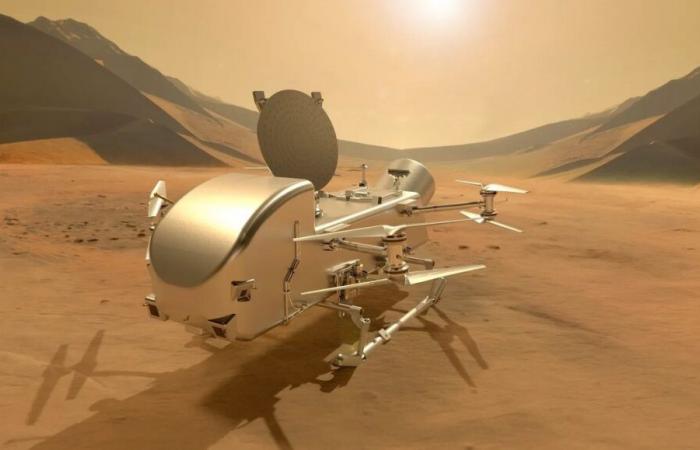
Dragonfly, the drone that will fly over the moon Titan.
© Nasa
It’s a very beautiful and very big dragonfly! This 850 kg drone (or octocopter) will fly in a few years in the atmosphere of the only moon in the Solar System that has one. Titan, which is also the second largest satellite after Ganymede with 5150 km in diameter, is such a fascinating world that this mission has been under discussion for years.
Advertising, your content continues below
But Titan is very, very far away, twice as far as Europa, this other moon visited by the Europa Clipper and Juice probes around 2030 and 2031. It orbits more than a million kilometers from Saturn, the ringed giant, itself a billion and a half kilometers from Earth.
Titan in front of Saturn, seen by Cassini.
© Nasa/JPL
NASA Dragonfly will leave with a SpaceX Falcon Heavy
NASA has therefore just attributed the launch of the octocopter to the same rocket as Europa Clipper, namely SpaceX’s Falcon Heavy. The shot is currently announced for 2028 with an arrival at destination planned for 2034 – yes, we told you, that’s a long way off. Dragonfly is part of the New Frontier program, established in 2019, which brings together American missions to explore our Solar System.
Packed with sensors, scientific instruments and cameras, this “dragonfly” is gigantic! Instead, look at this diagram on a human scale and the comparison with Perseverance, the rover currently exploring the planet Mars.
Comparison of Dragonfly with a human, Ingenuity and Perseverance.
© space.stackexchange.com (own work)
Advertising, your content continues below
And in this video where we discover the engineers at work (keep in mind that it is on a 1/2 scale).
But why the hell go to the moon Titan and not elsewhere?
Like Earth, Titan has an atmosphere and liquid lakes
Titan is truly unique in the Solar System, perhaps as much as Earth. Its atmosphere is rich in organic compounds and denser than the Earth’s atmosphere with a pressure one and a half times greater. In fact, this atmosphere really resembles that which our planet possessed before the primitive period of the Great Oxygenation.
And to complete the similarities with the Earth, Titan is the only other body in orbit (admittedly indirect since it orbits Saturn) around the Sun to host liquid lakes directly on the surface.
Photo taken by Cassini during its flybys.
© Nasa / JPL
Of course, this moon is so cold (around -190°C) that these lakes are not made of water, but of methane with a melting point of -182°C. Even more astonishing, Titan has a methane cycle with clouds, rain and lakes, just as on Earth we have a water cycle.
For a long time, scientists have wondered whether life would be possible under such conditions. Not a human existence of course, but another form than the one we know on our planet. Dragonfly will try to answer this question by analyzing the atmosphere of this strange moon on site.
Europe is also participating in the mission thanks to Cnes, which will notably provide the Dragonfly mass spectrometer, responsible for finely identifying molecular structures.
Remember that the Cassini mission of NASA and ESA succeeded in sending the Huygens lander in 2005 to Titan, making it the most distant world on which Humans have managed to land a machine. Here is the famous photo of an “extraterrestrial” world…
Photo taken by Huygens on the surface of Titan.
© ESA
And finally, a video presentation of the Dragonfly mission:
Advertising, your content continues below





